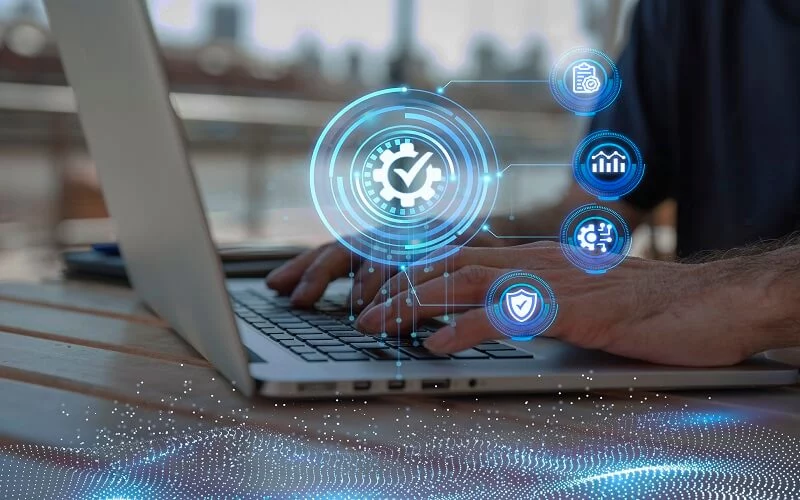Listen to the Podcast
Learn from the industry expert Joel Plaut, MS Office 365 SharePoint Architect, Reality Tech. on how modern technologies are shaping the future of the workplaces in our latest Podcast series TechStories along with Jay Mehta, Principal Solutions Architect, Cygnet Digital (A part of Cygnet Infotech) and our entertaining host Sanjeev Thakkar.
Subscribe to the podcast series to receive the latest episodes automatically.
Read Podcast
Sanjeev – Today, we are in conversation with Joel Plaut of Reality Tech. He’s a Microsoft Office 365, SharePoint Architect with a focus on everything SharePoint. And my name is Sanjeev Thakkar, AVP Marketing, Cygnet Digital (A part of Cygnet Infotech) your host, and with me is my colleague, Jay Mehta, Principal Solution Architect. So, Joel, welcome. How are you today?
Joel – Thank you so much, Sanjeev. It’s great to be here and great to talking with some of the deepest thought leaders in SharePoint and the Microsoft ecosystem.
Sanjeev – Oh, that’s nice. And we will be picking up your brain on that particular aspect. But just to set up the agenda, we wanted to kind of bring the whole idea of modern technologies, how they are shaping up the future of our workplaces, particularly in the context of COVID pandemic, how it has impacted everything from real estate, people, organizations, and operations.
As I know, the pandemic has caused this tectonic shift, where, when and how we work. So let us deal with this. Joel, I would request you to briefly give our audience a bit intro and what you do at Reality Tech. And perhaps, then we’ll take it onwards from there to SharePoint aspect.
Joel – Absolutely. Our focus really is helping our clients to get the very best how to use Microsoft products, SharePoint in particular, and to streamline all of the collaborative systems in use within companies. And that in itself, is changed dramatically for us and for our clients. As you point out, given the pandemic, which in some ways, has dramatically fast tracked the need for changes to the environment. Because overnight, resources had to work remotely and had to work from different locations, and all of a sudden, it was exposed within organizations, the kinds of work that required in person presence. And when people were working remotely, all of a sudden the issues and gaps surfaced.
Looking at our collaborative environments, we had to move very quickly to help clients to streamline to get their files off of file shares, to allow meetings and working sessions to run in a combination of virtual as well as in person and to organize and allow these things to move smoothly. So quickly, to be able to transform and move to that environment. Companies change their investment profile to prioritize the collaboration, environment, smoothing and streamlining for efficiencies and for competitiveness.
Sanjeev – Got it! I think that’s the reason why we have been hearing a lot about hybrid workplaces and how people are adapting to emerging styles. I would like to pick your brain again on what are the technology trends that you see coming up in 2023, as we start, and the two years later horizon, and how SharePoint is particularly playing that contribution in shaping the world ahead.
Joel – There are two trends that I’ve recently seen, one of which has been in the background for a long time. And that is integrative workflows, to be able to connect from people’s intranet to all of their different third-party systems, to allow tasks to be able to be tracked and managed within Office 365. There’s the whole power automate suite with forms and workflows. There’s a real interest in that right now.
The other big trend that we started to see is that companies came to SharePoint the other way. They’ve licensed Office 365. Everyone’s got it. They’re using it. It already comes for free with SharePoint, intranet capabilities, all these collaborative abilities with calendars, tasks, flows, learning management related systems, chat systems that integrate within IT teams, and they say, Hold on, I got all this stuff for free. How do I get off the old systems onto the new so some of that’s migration.
The other part is I got all these things. How do I make the best use of them within my company? And the last word, similar requests we get is, how do I balance the ability to have it open for people to do their ease of collaboration? But how at the same time to lock it down and make sure that it’s compliant with my policies, and that we don’t run significant security risks? Where’s that sweet spot on all of the policies that we’re setting and refine it?
Sanjeev – Right! Jay, do you have any thoughts particularly to add to this perspective that you have on the way that SharePoint is evolving?
Jay – One thing is that we have gone through the time of COVID. And organizations were not ready for this pandemic. And nobody has ever thought that how it would turn it out to be like, in like a bad to worse situation. So, this type of migrations has emerged as a key solution offering for the organization’s, they had a file shares, they were all behind their company’s firewall.
And then suddenly, you just see that okay, being at home, and you are eager to work, but you can’t access your resources. And that’s where the migrations to SharePoint was just becoming inevitable in a way where you have to bring the stuff on the office, or Microsoft 365. And that’s where you can have more and better accessibility. And that’s where you see that the business can operate competitive companies.
Sanjeev – Correct! And I think the key priority is to become device agnostic. So let me again, pick up one of the questions for you. Very specific to SharePoint, how enterprises are supposed to take leverage of it? What are the key metrics they should be looking for, in terms of exploring features? And how it changes all the implementation of, for example, from legacy to cloud or legacy to digital transformation kind of scenario?
Joel – That’s a great question and there’s a lot of parts to that answer. Because we’ve gone from a world where things were on premises and static, and you control the pace of those features. And it surface your control when you do an upgrade or a patch. In the new world, we’re moving much, much faster and then these features get exposed.
Microsoft does offer some metrics online, sometimes we integrate Google Analytics with some things to surface. Some decent metrics, we look across the size of the total footprint of content, the number of documents that are there, the velocity of the documents, sometimes we take a look into how much documents are copied, or emailed.
We want some of the trends that occur in the organic growth of the content. So we could see when there’s an issue, maybe some user training is needed so we can proactively get involved. We look at the frequency of doing periodic audits of what’s going on, for best practices, and the content can scale without fear of impacts on performance. So having something like a quarterly health check, we find is useful. And often there are latent issues that are worth talking about, before they blow up to be full-grown crisis.
Sanjeev – Then do you think security is one of the prime concerns for the business owners when they are getting into this traditional legacy way of working to digital way of working? Is that something that you I think we have?
Joel – We’re never going to get away from the concern about security, because that’s deeply what organizations worry about and its impact, and what will be the risks that come along with reputation, client data getting released… they worry about all of those things. But there are new capabilities that are not that well known within Office 365 that is Compliance Center and a number of governance capabilities. These has been here for a while but are not that well known. Information rights management, otherwise known as digital rights management of where licensing for access to files, so that they could be remotely revoked and these are some advanced capabilities.
Sometimes organizations have needs and sometimes call it data rooms, where they need to put some data and expose it to external clients, but we are able to prevent them from printing or downloading, or similarly, deeply restricting access. So that’s why conversations are good. On the other hand, I don’t see how office 365 can give me the security model, there are more and more features, I joke around Microsoft spends billions to make us all look good. And all we do is surface and configure these features that have been developed.
A lot of our goal is really while we do a lot of custom development, we try to avoid that. And we’ll surface creative ways to leverage what’s available out of the box to avoid writing code and the maintenance overhead. And we let the client make those trade off decisions.
Sanjeev – Correct! So there’s one special thing that we mentioned that, you know, Legacy enterprises as they are transforming, is there any particular experience that you would like to showcase where the versioning has made the systems obsolete? And now we suddenly are going beyond our capability abilities to transform that particular enterprise? And, you know, bring them up to mark? Is that any particular challenge that you face? Would you like to focus on that?
Joel – Another great question, Sanjeev! Because sometimes we’re just doing a simple on premises upgrade to the cloud. And sometimes it’s simple work. It’s apples to apples. But then there are some migrations that we do, Jay and I did Documentum migration to SharePoint, I’ve done others too. We’ve done Confluence and there are other interesting discussions we’re having, we’re doing open text migrations now and not every source object maps the destination object, and there are different ways to do it, different pros and cons. So we got some creativity that’s involved in how to do the mapping. And we have some training to do because the source system is not going to look exactly like the destination system.
But these are all real opportunities, not just flattening the overall licensing model of your collaboration environment. But where everything’s connected, the documents are where the tools are, and everything’s linked together and flows simultaneously. You could have alerts, workflows, and integration, all at one platform. So those are the most interesting migrations from unusual source systems. And that’s where, people want to talk to the experts, people have done this before. And it’s people who can roll up their sleeves and do little bits of custom coding, where it’s needed on the migration.
People who could really think out of the box on how to creatively do that migration, as well as train the end users, resulting in a happier user base and improved collaboration environment, something that’s supportable, centralized, and not a fragmented set of legacy systems.
Sanjeev – Getting from people to process, everything have to be upgraded. Jay, would you like to share some thoughts on that?
Jay – Yes, absolutely. So while we do the migration, sometimes we can easily bring data back to the newer system. But as Joel has mentioned, he’s also seen that there are trade off for the customers that they lose their UI, they lose the front end part as well, because that’s not going to be the same, you get from the legacy system to the newer ones.
There is another emerging need coming out around that, especially coming from the business and power users, those who has a sort of background about SharePoint. So they demand like we have our data, but how can we just start building our own applications. And that’s where we see another emerging technology coming out of it, that is low code, no code solutions offered by Microsoft, that is Power Apps. And it is coming up with a lot of other features as well. Like if you still need a workflow, which is actually one of the forte from SharePoint.
The same thing, you can have it through power automate, in terms of reports and dashboards, you can still use the overall power suit with respect to Power BI. So that’s where these emerging needs are also coming up to these migration challenges quite effectively. And it also needs very less amount of training for the business users to build their own applications and host them in the same ecosystem.
Sanjeev – Interesting! You mentioned about low code, no code as well, I would like your perspective on that Joel.
Joel – Sure! I agree completely with Jay. Power automate and over the Power Apps platform, we’ve seen users very, very happy. We love empowering, just like you said, those power users can create or edit, the more they do, the more it pushes the limits. And we’re there to help that kind of second tier of guidance support. These Power Apps integrate so easily.
There are so many third-party adapters in which the user interface and the user experience is really good, it’s responsive. And it just works for users. We’ve had a lot of success with it. It’s very manageable. And we’re very happy, greatly working in that environment. And it is the future of low code, no code too.
Sanjeev – That leads me to the important question, what for RealityTech from here onwards?
Joel – You know, it’s a funny thing, because the more we empower users, the more successful they are. But there’s always more opportunity for us to assist on the outside. For RealityTech, we’re happy to share what has worked for clients, and what doesn’t work, what are the best practices, and we share from all of our deep experiences and empowering users.
And to us, the ultimate success is when the client becomes self-sufficient and we are there behind them, and we want them to be empowered because they can best help themselves directly with us. We are always behind them. They have a long-term partner.
Sanjeev – Great! And that leads me to one selfish question, and the last one to go. How do you see partners like Cygnet Digital, co-creating with the tech partners like RealityTech and others?
Joel – Well, Cygnet brings so much to the table. And this is why I make it my personal mission, to visit Cygnet as frequently as I can. So learn about the products that you’re developing and the cutting-edge solutions that you’ve done. And your experiences then become our experiences to collaboratively share with clients. Right?
Cygnet Digital brings a wealth of experience, and access to more systems, than anyone else that I know. And a long-term trusted partnership that allows exploration, Jay and I often talk about difficult technical challenges for which we don’t each has the solution. But when we put our heads together, new creative ideas come out. And these are things that give us our deepest joy, being able to share these creative ideas with our clients.
Sanjeev – Thank you so much Joel, would you like to add something to this Jay?
Jay – Well, I would say, this is like more than a decade-old relationship we have with RealityTech. And it is always, sort of a learning experience for us. And why it is learning because you never fail, actually. But it’s learning in terms of like, taking and talking to customer understanding client’s pain, their challenges, and when we solve them. And what makes us happy is because the client is just happily adopting the solution. I mean, usually, people just come and give the solution. And that’s the end of the story. But that’s not for us.
Having this relationship is beyond. Externally, it doesn’t end there. It is just like when we see that the people at the client side they are using our solutions. They are sharing feedback, whether it’s positive or negative. But yes, that’s what it is. Because if there is more and more user adaptivity around the solutions, that’s where we can nurture our relationships amongst ourselves and within.
Sanjeev – Amazing! With this, we come to the end of this conversation. Thank you so much Joel! Before we wrap it up any other words that you Joel would like to share or Jay would like to share or we call it a close depending on you.
Joel – I just want to thank you for your hospitality, long term friendship. It’s been a win-win from day one for over a decade. RealityTech and Cygnet Digital work awesomely together. Thank you so much.
Sanjeev – Thank you, guys! If you have any other questions, do come in back to us and we’ll be happy to reply. You can write to us at enquiry@cygnet-digital.com Thanks for listening!








